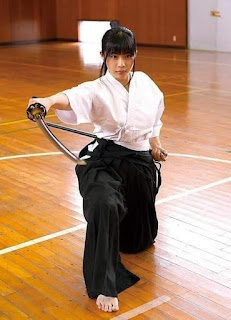By Phillip Starr
“...We all complain about the “modern, sportified” versions of our martial arts that have taken the stage. With their diving punches (and taps on the head), to their homemade, eclectic forms that include gymnastic maneuvers, kiais that sound like a cat being beaten with a trash can lid, and techniques that are all flash and no substance, they have thrilled audiences and convinced many people that this is the stuff that martial arts are made of. They twirl their weapons like batons, toss their swords into the air, and otherwise demonstrate a massive amount of bravado (but no real skill) while we stand in the shadows, puffing out our chests and say, “Look at that silliness! I'm sure glad that I practice an authentic martial art!” And therein lies a big part of the problem.
To begin with, WE allowed these kinds of performances into our competitions. Trying to be “politically correct”, give everyone a fair chance, and not wanting to hurt anyone's feelings, WE let things slide, inch by inch. And those inches started adding up. If someone performed a flying side kick at the end of a basic karate form (such as Heian Nidan) and the competitor insisted that his instructor had taught him to do it that way, we let it go and judged him on “level of difficulty.” Before long, participants began making up their own forms!
And who was to say what a correct reverse punch or roundhouse kick was? This became even more apparent with the advent of padded gloves and footgear; fighters began using boxing punches and any kind of kick would suffice. If you could simply “touch” the other guy with your glove, you'd score a point...regardless of “correctness” of technique!
And we stayed in the shadows and watched. We watched as competitors entered Weapons Forms competition with all kinds of bizarre “martial arts weapons” - from meat hooks to tomahawks, Bowie knives, and 3-inch thick staffs with colored flags attached to the ends. And we chuckled as we stood ramrod straight, secure within our time-honored traditions.
We forgot, or perhaps never considered, that the audiences see only what is in the limelight. They don't look into the sidelines or shadows. They were being told that what stood in the limelight was the real thing and because they simply didn't know any better, they believed it! And those were/are the people to whom they flocked to enroll in classes while we wondered what had happened?”
The Japanese got it right in so far as tournaments are concerned. For freestyle sparring, only traditional technique is acceptable and in order for it to be accepted as a point (or half-point), it must meet very strict criteria. There are no flip-kicks, diving punches, or taps on the head. For forms competition, competitors are permitted to perform only certain traditional forms. The officials are more than a little familiar with all of them. We would have done well to follow their lead.
I remember back in the days of the USKA (United States Karate Assoc.) tournaments. It was not unusual for a competitor to have to provide the name of his form in both English and its native language, and at the conclusion of the set, officials would sometimes call competitors to the front and ask questions about the form.
Many years ago, my kung-fu uncle, Ming Lum, gave me an idea. Once a month, he'd host a meeting of the traditional martial arts teachers in his area (San Francisco). They'd have tea or coffee with some doughnuts or other Chinese pastries and just talk. Ming said he never directed their conversations; he'd just listen to everyone talk about their families, work, weather... but it all eventually got down to the same thing; martial arts. And that's where he'd jump in. They all made sure that their events didn't step on each other's timelines, and so on. Ming said this was a good idea because it kept the lines of communication open and prevented hard feelings from developing.
I used his idea in putting together meetings of traditional instructors in my area and we organized large public demonstrations of REAL martial arts. We stepped out of the shadows and back into the limelight to show people the differences between what they might have seen via Hollywood or open tournaments and the traditional, authentic disciplines. I think this approach is a good start. What do you think?


























No comments:
Post a Comment